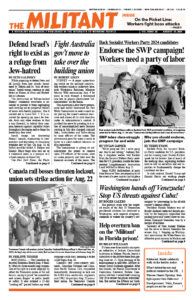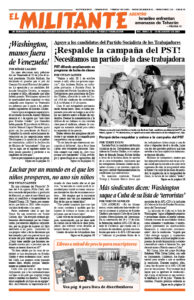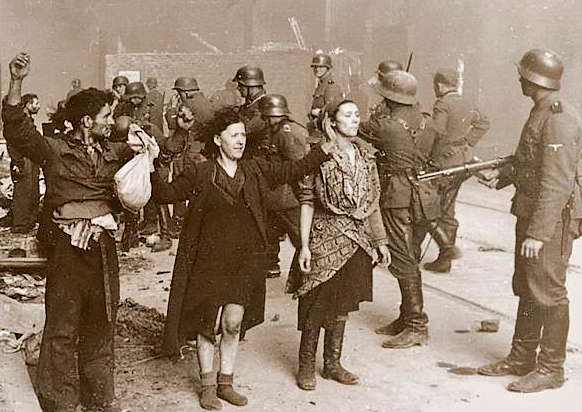This year marks the 81st anniversary of the Warsaw Ghetto Uprising — one of the first and the largest act of armed resistance against the Nazi Holocaust to exterminate the Jews. A year later in August 1944, Polish workers rose up in this capital city of Poland against Adolf Hitler’s brutal occupation forces.
Prior to World War II, Warsaw was a major center of Jewish life and culture in Poland. Its Jewish population was about 375,000, the largest of any city in Europe.
After the signing of the secret Stalin-Hitler pact, where the two rulers agreed to conquer and divide Poland, German forces invaded on Sept. 1, 1939, marking the start of the second imperialist world war. Stalin ordered Moscow’s invasion from the east in mid-September. By the end of the month Hitler’s forces occupied Warsaw. The country was partitioned between Germany and the Soviet Union.
The Nazis established the Warsaw Ghetto one year later as part of implementing Hitler’s “Final Solution” to rid Europe of Jews. They were confined under harsh, unlivable conditions until they could be executed. This ghetto was only 1.3 square miles. Jewish families were given just two weeks to relocate there, forfeiting all their possessions.
The ghetto was sealed off within a 10-foot wall topped with barbed wire. Entering and leaving without a special work permit was prohibited, enforced by armed guards.
The population of the ghetto at its high point exceeded 450,000. Many had no housing or were forced to live nine people to a room. Overcrowding exacerbated the spread of disease. Food provided to Jewish residents was at starvation levels. Thousands died there each month.
Despite these conditions, Jews found ways to resist — through music, poetry and theater expressing their cultural heritage. This is described in Warsaw Testament, a book by Rokhl Auerbach recently published in English for the first time. She was part of a team of 60 Jews living in the ghetto who worked together to write about and archive their experiences. Only Auerbach and two others survived the war.
In July 1942 the Nazis began mass deportations from the ghetto to the Treblinka concentration camp, built specifically for their murder. Over the next two months 265,000 Jews were systematically slaughtered there, while German SS and police units murdered another 35,000 of the Jews who remained in the ghetto.
That summer several Jewish underground groups banded together and formed the Jewish Fighting Organization (ZOB). It included members of Zionist groups, socialists, communists and the Bund. They were joined by a second force called the Jewish Military Union (ZZW), established by the Betari Youth.
The uprising began on April 19, 1943, when 2,000 German army troops moved into the area with tanks, rapid-fire artillery and ammunition trailers. They were met by some 1,500 ZOB fighters and others who opened fire with pistols, a few rifles, a machine gun and homemade grenades, fighting German forces in hand-to-hand combat.
At the time, only 50,000 Jews remained alive in the ghetto. Jews hid in underground bunkers, refusing orders by German authorities to assemble at collection points for deportation. By the end of the day German troops were forced to retreat outside the ghetto wall, with 12 of their soldiers killed or wounded.
The German forces then used gas and flamethrowers to force the Jews from their bunkers. The Nazi brass made a decision to burn the entire ghetto, which their troops began to carry out block by block. The ghetto fighters and the civilian population who supported them held the Nazi army at bay for nearly a month, until May 16. On that day German Gen. Juergen Stroop ordered the destruction of Warsaw’s Great Synagogue.
The Jewish resistance in Warsaw inspired uprisings in other ghettos, such as in Bialystok, and in the killing centers of Treblinka, Sobibor and Auschwitz-Birkenau.
1944 Warsaw Uprising
A year later on Aug. 1, 1944, another uprising began throughout the city of Warsaw. Inside occupied Poland, anti-Nazi resistance was organized around the Home Army, an underground military organization that backed the Free Polish government-in-exile in London.
By that time Hitler’s forces had suffered serious defeats on the Eastern Front and were forced to withdraw from its invasion of the Soviet Union. Soviet tanks had reached the eastern suburbs of Warsaw when the uprising by Polish forces to liberate the city began.
The Home Army had at its disposal about 40,000 fighters — including 4,000 women — but no more than 10% of them were armed, mostly with light weapons. The German forces were heavily armed, with tanks, artillery and planes. What followed was nine weeks of intense fighting, the longest and bloodiest urban insurgency of the Second World War.
Soviet forces stationed on the eastern bank of the Vistula River in Warsaw passively watched as German forces massacred the Polish residents. Joseph Stalin’s government refused to offer support, fearing it would strengthen the Polish government-in-exile and make more difficult his growing control over the region. The Soviet military, which controlled six airfields in Poland, provided no air or artillery support. The imperialist Allied forces of Washington and London did virtually nothing to help either. Franklin Roosevelt even turned down a suggestion from British Prime Minister Winston Churchill that they issue a joint request for Stalin to aid the Polish rebels.
The fighting stopped Oct. 2, 1944, with the formal surrender of the Home Army. Polish losses during the uprising included 150,000 civilian deaths, and 20,000 Home Army casualties. German forces lost about 10,000 troops. Over the next three months German forces demolished much of what was left of the city and deported 650,000 Polish civilians to a labor camp south of Warsaw.
In January 1945 Stalin sent Soviet troops in to “liberate” what was left of Warsaw.


